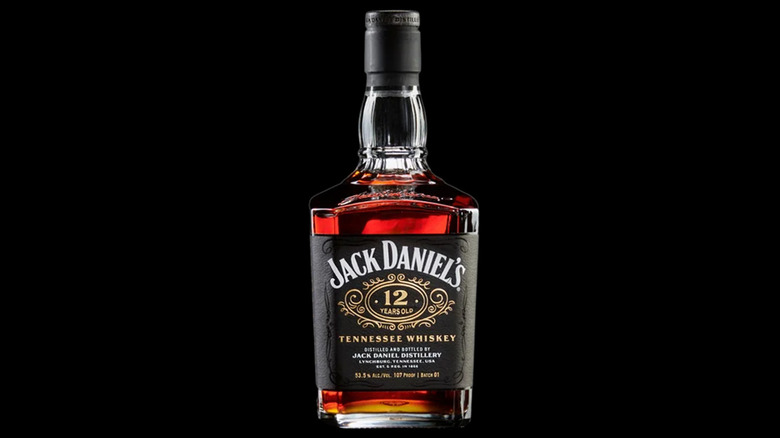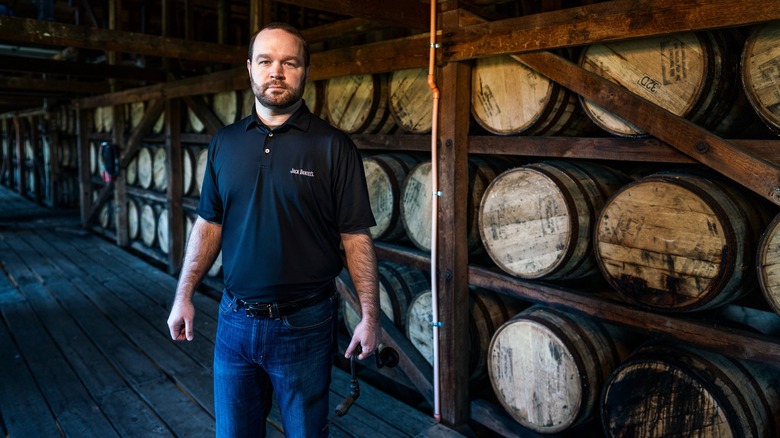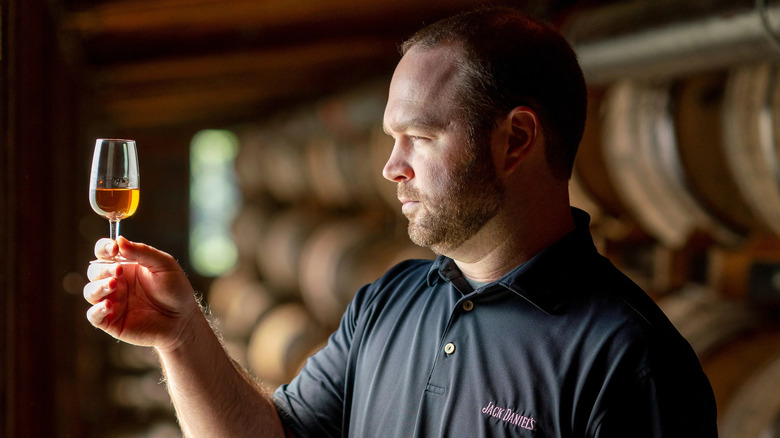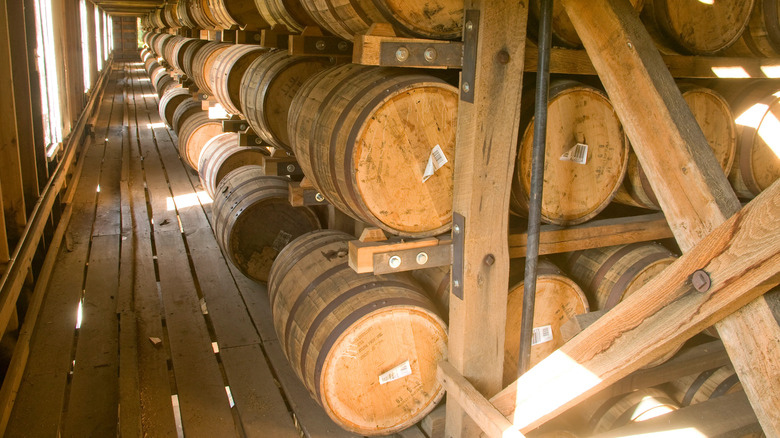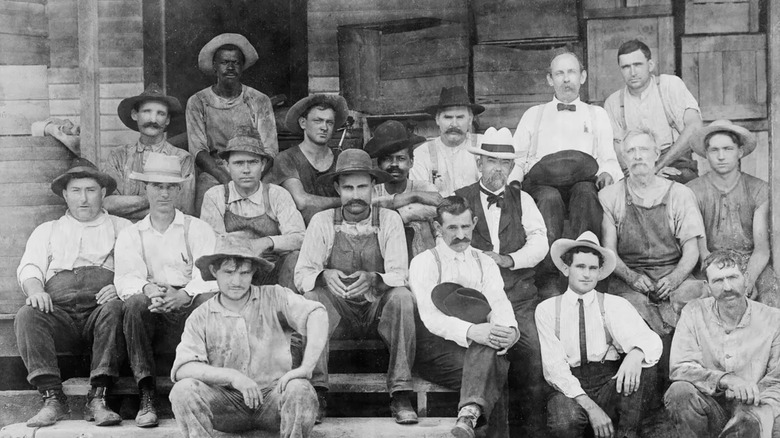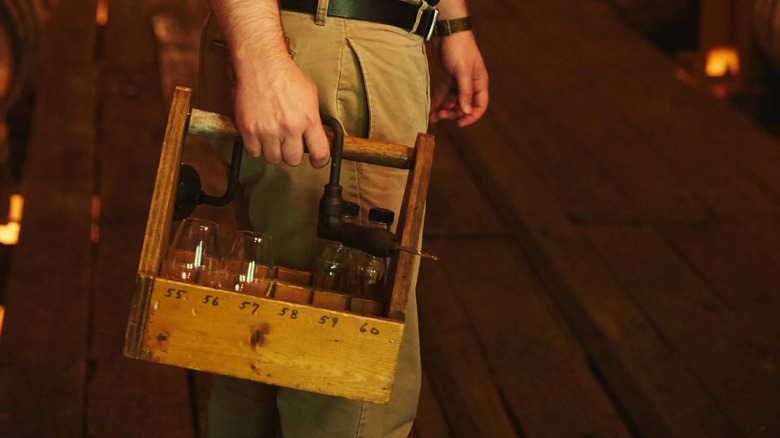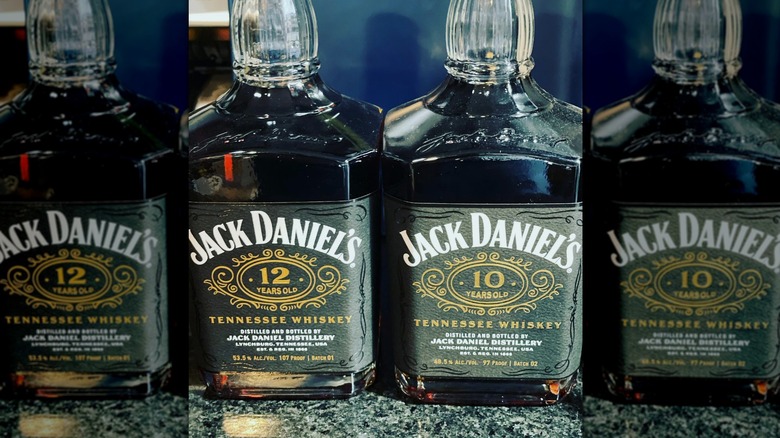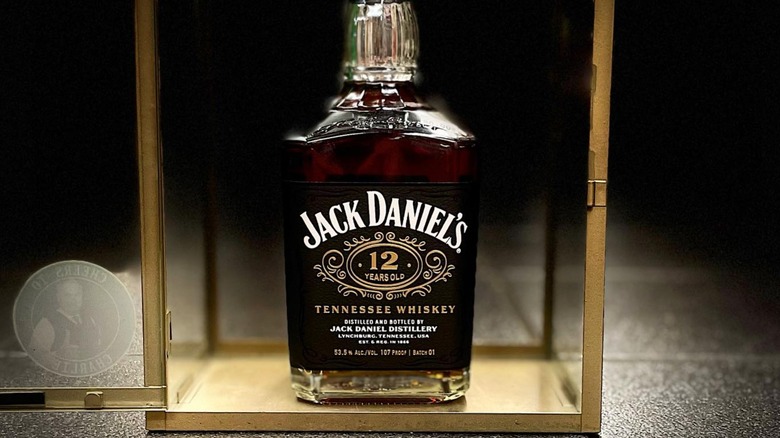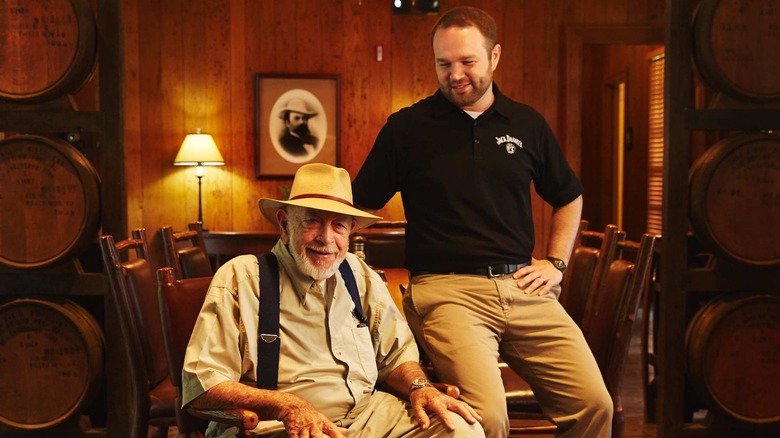Why Jack Daniel's 12 Is The Biggest Whiskey Release Of 2023
It's hard to believe it these days, but there was a time when Old No. 7 — the ubiquitous black label that adorns every bar in America — was an allocated product. Back when Frank Sinatra was talking it up as the nectar of the gods to anyone who would listen, Jack Daniel's main product wasn't produced in enough quantity for America's thirst. Whether or not that's the result of Ol' Blue Eyes' influence or other famous devotees like Van Halen and Motörhead, we can't say (and leave it for the music historians to determine). We're more concerned with the present, as Jack Daniel Distillery has released the new 12-Year expression of its famous product. It looks like the old times are back because you can't find it anywhere. And if you do, you either know somebody or have money to spend. It's clear why it was an easy pick among the best whiskeys of 2023 (so far).
But that's just part of why the 12-Year's first batch is so significant. From a production standpoint, it results from the evolution of the brand and distillery. Production now looks very different from the '80s, when Jack Daniel's master distiller Frank Bobo bottled his last batch. To hear more about the present and future of the brand, we spoke with his grandson, Jack Daniel's latest master distiller Chris Fletcher. We discussed the 12-Year's success, the changing face of distillation, and a legacy encompassing the entire town of Lynchburg, TN.
Jack Daniel's 12-Year sold out immediately
30,000 bottles is a lot of bottles. But compared to the average Jack Daniel's output of about 126 million liters per year, it's a drop in a literal bucket, if not one in thousands of casks. Yet despite a lake's worth of Jack Daniel's, these 30,000 bottles of 12-Year stand out as so worthwhile they've vanished from shelves.
Shortly after reviews started to land about how the 12-Year expression is the fulfillment of Jack's potential, handles disappeared, and prices skyrocketed to almost $400 a bottle — something heretofore seen mainly with the Jack Daniel's Single Barrel Special Release Coy Hill High Proof. The consensus was clear: 12-Year was something else. The 10-Year expression had been well-regarded as a fine development of everything that made Jack Daniel's attractive, but it was obtainable. With the first batch of 12-Year, something truly noteworthy has occurred. You'd be hard-pressed to find Jack 12 in a bar or retail store, even in a major urban area, short of calling some high-end venues with whiskey-focused shelves. If future expressions remain this desirable, that bottle might become historically expensive as the first appearance of a new legend.
Jack 12 has been in the works for almost a decade
Chris Fletcher has been Jack Daniel Distillery's master distiller since the back end of 2020, but the plan to expand the offerings has been in play for years."I would say we really started focusing in on innovation around 2015 or so ... just figuring out some different ideas that eventually led to the Bottled in Bond," says Fletcher.
It's been a century since the Jack Daniel's label put out a 12-Year. Typically, it hasn't even been age-stated. Fletcher says recreating a product that hasn't been around since Daniel himself was exciting and a lot of fun to figure out, even with its new challenges. Aging whiskey to perfection is no quick process, and distillers and blenders have to think in terms of future moving parts: literally moving the aging liquor in this case.
Fletcher recounts that around 2018, the team "went back and started holding back some barrels on the top floor. Locations that would be single barrels' location." Most of the barrels that would become Jack 12-Year were in their eighth year then and running strong towards a robust whiskey taste. Fletcher describes the stuffy air on the distillery's top floor as prime real estate that catalyzes the aging process. (It's why we see such powerful bourbons with short age statements coming out of Texas, such as with Still Austin whiskey.)
12-Year changed the production process
Barrels typically don't move around the Jack Daniel rickhouses. If a barrel's up top, it's likely reserved for single-barrel release. "The top-floor single barrel is about the only hard and fast rule as we have," says Chris Fletcher, noting that "well over half" of the single barrels are generated from the top of the company's 96 barrel houses. And those barrels stayed put until what would become the pronounced extra-age statement experiments.
But aging a barrel isn't just set it and forget it. "If a location or floor is a big enough deal, we've done the work to know why," Fletcher says. Samples are taken, metrics are compared, and the new Jack needed to slow its development in the barrel. Fletcher and company relocated barrels — something the distillery had trialed in the 10-year process — to slow their roll and reach the 12-year statement cautiously.
Moreover, Fletcher's team had to work out the formula to successfully recreate the 12-Year that Daniel himself once made since production notes, even when available, never contain the detailed formulation and instruction for our modern era.
Fortunately, methods had been changing and growing all this time, providing Fletcher and his distillation team much more insight into how their babies are napping than Jack Daniel could have conceived in his time ... and even beyond what Fletcher's grandfather used. A wealth of data gave the JD crew confidence to tweak and test, knowing what to expect from their variables.
12-Year uses novelty to revisit the past
The 20th century pioneered the homogenized guarantee in spirits, and Jack Daniel's Tennessee Whiskey was no exception. Chris Fletcher recalls his grandfather, Jack Bobo, blending many barrels into a recognizable, recurring product. That's still a huge part of the Brown-Forman brand's output — Fletcher says Jack's main output is Old No. 7, comprised of hundreds of barrels each batch. Still, the 21st century has seen the brand create new experiences for an audience that embraces novelty.
The kicker is that labels like 12-Year recall Jack Daniel's 19th-century offerings. While all Jack Daniel's bottles ferment via the distillery's proprietary yeast culture from 1938 — and most use Jack Daniel's classic mash bill of 80% No. 1 corn, 12% barley, and 8% rye — how they're treated at each stage affects the outcome. Fletcher says the rye distillate only needs to pass through three feet of sugar maple charcoal to mellow out any graininess, oiliness, and bitterness due to a softer mash bill that's 18% corn. Compare this to the 80% in the Tennessee whiskey, which passes through a 10-foot length of maple to become classic Jack or 12-Year.
"We're able to continue to push new flavor profiles into it with aging and to do it in a way that pays a lot of homage to what Mr. Jack did," Fletcher says, "even down to how the label was designed." While no one alive can compare its taste to that long-gone whiskey, distillery experts still analyze Daniel's methods.
12-year production is the intersection of science and art
New tools and reams of data allow Jack's distillers to experiment with confidence, pinpointing desired effects. They know enough to be comfortable playing in what they don't know. But with all the insights and analytics out there, greater science requires greater art. The more expertise and nuance, the more collaboration and communication are required to tie it all together in target dates that can be ahead by more than a half-decade.
"It's never any just one person when it comes to making whiskey, that's for sure," says Chris Fletcher. "It takes a village."
A lot of acclaim ends up with the Master Distiller, but the industry should avoid falling into auteur theory. Fletcher shows how by being quick to credit his team's decades of experience, much of which precedes him as Master Distiller. Without the on-the-floor knowledge of a crew — from grain to mash to distillate to barreling and bottling — production might go well beyond expected parameters. With it, there's less unknown, and the result gets closer to where the team desires.
"We don't experiment a lot," he says. "We come up with a plan," such as making the call to move the barrels for the 12-Year, and knowing when and where to move them. Fletcher continues, "We've got great people that have been doing this for years and years and years. When you have that team, it takes a lot of the trial and error out of it."
This release could be the herald for more age statements
While Jack Daniel Distillery is working on future 10-Year and 12-Year releases, Old No.7 Black Label remains its main offering. Still, there are deeper age statements to figure out, and Chris Fletcher's team is up for the challenge. The distillery is swimming in data and knows which adjustments yield what changes, so it can determine the principles at work when reviving products that existed before machinery and metrics.
Without committing to numbers, Fletcher does tease more age-stated whiskey, mentioning that Jack Daniel also released barrels aged 14, 18, and 21 years. "This is part of our history," he states. "I would love to tell you we're going to recreate it perfectly, exactly as Jack did it in his day. That would be my ultimate goal. But if it's not right, we're not going to do it just to say we've done it."
But what's that about more 12-Year? "We all love to say it's going to be a lot more, but I don't think that would be a very honest thing," he laughs. "It's a really special product. Yes, we do plan to make more, but I'm not going to be able to make any promises about how much."
And 12-Year shows that premium and novel expressions are all around
Don't fret if you chase variety but have trouble finding the age-statement stuff. Jack just introduced barrel-proof single-barrel rye, and there were interesting releases like the Coy Hill High Proof in 2021, says Chris Fletcher. And Jack Daniel's dipped its toe into American single malt with a sherry cask finish for its fifth annual special release in 2022.
Grateful for the history and success of the brand, he says that last decade's American whiskey boom has brought in a devoted customer base that doesn't just consume but studies and explores. "People are interested in tasting different things and different flavors. And also they want to know about the process and how we're able to do that." Fletcher is open to more experimentation for related products.
"I've been really confident that if we want to try different corn, different this and that," he says, "we're going to make great whiskey out of it." Fletcher goes on to note that such adjustments and changes may require more or less time in the barrel, but by the time it reaches you, he'll be certain that it stands up to the label's reputation.
The legacy is liberating
It's fitting that the 12-Year comes from a distiller who has a legacy in this role — though Chris Fletcher is the first to tell you that much of Lynchburg has a family history behind that label. The company is built by and of families who take proud ownership of this American icon. "Well over half of our employees here either have or have had family members that worked here," he says, noting his sister and cousins have also taken on roles.
Fletcher might be one of the few people in America whose offices come preloaded with family photos, and that's truly special to him on a personal level. But with four decades' change between his grandfather's retirement and his own acceptance of the role, he's less worried about living up to a heritage and more excited to ask, wouldn't granddad love this?
"If my grandfather were still here, what would he think about our 12-year-old whiskey?" he muses. "I don't think pressure's the right word ... It's a sense of pride."
We can't speak for Frank Bobo, but based on popular reception of the 12-Year, pride would be the word. Precision techniques have let Jack Daniel's whiskey claim both its recent legacy of reliability and its past one of novelty. Once a tightly distributed product, then a ubiquitous standard, and now elevated back to an allocated unicorn, Jack 12 brings the brand full circle by offering both.
